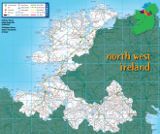North West Ireland Tourism
Visitor Guide to Mayo, Sligo, Donegal, Roscommon, Leitrim, Cavan & Monaghan
Visitor Guide to Mayo, Sligo, Donegal, Roscommon, Leitrim, Cavan & Monaghan
| 0-9 A B C D E F G H I J K L M N O P Q R S T U V W X Y Z |
The Céide Fields
The remarkable neolithic site at Céide Fields in County Mayo holds the oldest known stone-walled fields in the world. They date back almost 6,000 years, more than any other early agricultural site to date. The Céide Fields overlook the mighty Atlantic Ocean which pounds vigorously against the cliffs below. The landscape itself has been forged from the dramatic upheaval of the earths crust over millions of years, and by the ferocious winds which frequent this exposed coast. And together they have built a landscape of extraordinary frugality and beauty. And it is here that our neolithic relatives came to build their fields, and plant their crops, and raise their families.
In the 1930s cutting turf was the traditional way for heating homes across much of Ireland and certainly in the small village of Belderg. The village is situated on the wild and beautiful coast very close to the Céide Fields. As he cut turf in preparation for the coming winter, the local schoolmaster, Patrick Caulfield, kept coming across large numbers of stones deep down in his patch of bog. It occurred to him these stones appeared to be placed in regular patterns. The depth at which the stones were found indicated that they must have been placed there many centuries ago. Years later his son, Seamus Caulfield who studied archaeology, investigated further, and discovered evidence of cultivated fields, houses and tombs which had lain hidden for many many centuries. Using iron probes, Seamus and his team traced out a pattern of walls. These walls were then “mapped” by the insertion of bamboo poles and this gave a visual display on the surface as to the pattern and direction of the stones over many acres.
Six thousand years ago, our Stone Age ancestors constructed houses, walls and fields, and created early farming communities, complete with megalithic tombs. The Céide Fields is perhaps only one of many of these undiscovered sites. It had stone-walled fields, a farming community, and a countryside of homes scattered throughout the landscape with houses surrounded by garden walls. Indeed it sounds very much like Irish life in more recent years. We know from artifacts found on the site that these ancient farmers used wooden ploughs with a stone cutting edge for cultivating fields. These were drawn by cattle as horses had not been introduced into Ireland at this time. A typical single round house measured about six metres in diameter.
Daily Opening Hours: 10.00 – 18.00 June until end of September.
Phone: (+353) 096 43325
Book The Céide Fields Accommodation
In the 1930s cutting turf was the traditional way for heating homes across much of Ireland and certainly in the small village of Belderg. The village is situated on the wild and beautiful coast very close to the Céide Fields. As he cut turf in preparation for the coming winter, the local schoolmaster, Patrick Caulfield, kept coming across large numbers of stones deep down in his patch of bog. It occurred to him these stones appeared to be placed in regular patterns. The depth at which the stones were found indicated that they must have been placed there many centuries ago. Years later his son, Seamus Caulfield who studied archaeology, investigated further, and discovered evidence of cultivated fields, houses and tombs which had lain hidden for many many centuries. Using iron probes, Seamus and his team traced out a pattern of walls. These walls were then “mapped” by the insertion of bamboo poles and this gave a visual display on the surface as to the pattern and direction of the stones over many acres.
Six thousand years ago, our Stone Age ancestors constructed houses, walls and fields, and created early farming communities, complete with megalithic tombs. The Céide Fields is perhaps only one of many of these undiscovered sites. It had stone-walled fields, a farming community, and a countryside of homes scattered throughout the landscape with houses surrounded by garden walls. Indeed it sounds very much like Irish life in more recent years. We know from artifacts found on the site that these ancient farmers used wooden ploughs with a stone cutting edge for cultivating fields. These were drawn by cattle as horses had not been introduced into Ireland at this time. A typical single round house measured about six metres in diameter.
Daily Opening Hours: 10.00 – 18.00 June until end of September.
Phone: (+353) 096 43325
How to get to the Céide Fields
By bus, or car. Bus Eireann Route 446 serves Balderg from Ballina. Alternatively follow the R314 west from Ballina to Balderg.Where to stay near The Céide Fields
The Céide Fields has fine selection of places to stay nearby including hotels, hostels, self-catering holiday homes, guesthouses and B&B's.Book The Céide Fields Accommodation
Explore more
Balderg is surrounded by beautiful coastal towns. Don't miss Killala and Ballina if you are travelling north, and don't miss Portrurlin, and Portacloy, if you are travelling south.Things to do near The Céide Fields
- Try your hand at fishing from Balderg’s protected harbour where you are likely to catch turbot, flounders, mackerel, and pollack.
- Deep sea angling along this coast is generally very rewarding, especially if you have local knowledge aboard. Your catch is likely to be much more varied than above.
- Explore the walking trails on the high grounds behind the Céide Fields, and enjoy magnificent views over the Atlantic and over Killala Bay.
- Make sure that you don’t miss the extraordinary cliffs immediately adjacent to the Céide Fields Interpretive Centre. Walk down to the viewing platform but not beyond.






